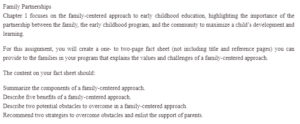The Family-Centered Approach to Early Childhood Education
The Components of a Family-centered Approach
The family-centered approach to early childhood education emphasizes the importance of the partnership between the family, the early childhood program, and the community in maximizing a child’s development and learning (Wardle, 2013). The critical components of this approach include:
- Family involvement, where families are actively engaged in their child’s education. They are involved in decision-making and considered equal partners with early childhood educators.
- The collaborations between the family, the early childhood educators, and other professionals are also essential to providing the child with the best possible care and education (vilaseca et al., 2019).
- Community support is also necessary to ensure families have the resources to succeed.
- The approach also emphasizes considering family contexts when deciding policies and practices. The contexts refer to the family’s culture, values, beliefs, and socioeconomic status.
- When these factors are considered, they allow for more culturally responsive and appropriate practices.
- The policies and procedures should also be family-friendly and easily accessible to all families. For instance, family-centered conferences are a vital component of this approach.
Benefits of a Family-Centered Approach
The family-centered approach has numerous benefits for both the child and the family.
- It allows the child to receive individualized care and attention responsive to their unique needs (Hughes-Scholes & Gavidia-Payne, 2019).
- The family is also actively involved in the decision-making process, which can help to build trust and confidence between the family and the early childhood educators.
- In addition, this approach can help to improve communication and collaboration between the professionals working with the child and family.
- It can also lead to more culturally responsive practices that respect the family’s culture, values, and beliefs.
- Finally, the family-centered approach can help to empower families by providing them with the resources and support they need to be successful.
- Furthermore, it can help build strong and lasting relationships between the family and the early childhood educators.
Two Potential Obstacles
A few potential obstacles can occur when implementing a family-centered approach.
- One obstacle is the lack of communication between professionals working with the child and the family (Wardle, 2013). This can happen without a clear communication and collaboration plan or process.
- Another obstacle is that some families may feel like they are not being listened to or respected. This can happen if early childhood educators do not consider the family’s culture, values, and beliefs when deciding policies and practices.
- Finally, some families may not have the resources or support to succeed. This can happen if the community does not provide adequate resources or the early childhood program is not family-friendly.
Two Strategies
It is essential to have a clear plan and process for communication and collaboration between the different professionals working with the child and family to overcome these obstacles (Vilaseca et al., 2019). Early childhood educators must consider the family’s culture, values, and beliefs when deciding policies and practices. In addition, it is essential to provide families with the resources and support they need to be successful. Some ways to do this include:
- Establish clear communication channels between professionals working with the child and family.
- They ensure that all decisions about policies and practices are made in collaboration with the family (Hughes-Scholes & Gavidia-Payne, 2019).
- We are providing families with resources and support, such as access to transportation, child care, and parenting classes.
- Creating a family-friendly environment in the early childhood program.
By implementing these strategies, it will be easier to overcome obstacles and enlist the support of parents. In addition, these strategies can help to build strong and lasting relationships.
References
Hughes-Scholes, C. H., & Gavidia-Payne, S. (2019). Early childhood intervention program quality: Examining family-centered practice, parental self-efficacy and child and family outcomes. Early Childhood Education Journal, 47(6), 719-729.
Vilaseca, R. M., Galván-Bovaira, M. J., González-del-Yerro, A., Baqués, N., Oliveira, C., Simó-Pinatella, D., & Giné, C. (2019). Training needs of professionals and the family-centered Approach in Spain. Journal of Early Intervention, 41(2), 87-104.
Wardle, F. (2013). Collaboration with families and communities [Electronic version]. Retrieved from https://content.ashford.edu/
ORDER A PLAGIARISM-FREE PAPER HERE
We’ll write everything from scratch
Question
Family Partnerships
Chapter 1 focuses on the family-centered approach to early childhood education, highlighting the importance of the partnership between the family, the early childhood program, and the community to maximize a child’s development and learning.

The Family-Centered Approach to Early Childhood Education
For this assignment, you will create a one- to two-page fact sheet (not including title and reference pages) you can provide to the families in your program that explains the values and challenges of a family-centered approach.
The content on your fact sheet should:
Summarize the components of a family-centered approach.
Describe five benefits of a family-centered approach.
Describe two potential obstacles to overcome in a family-centered approach.
Recommend two strategies to overcome the barriers and enlist the support of parents.

